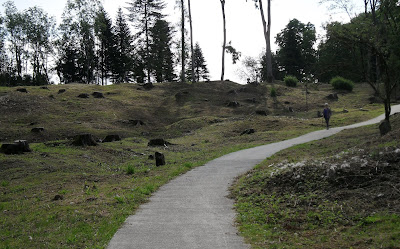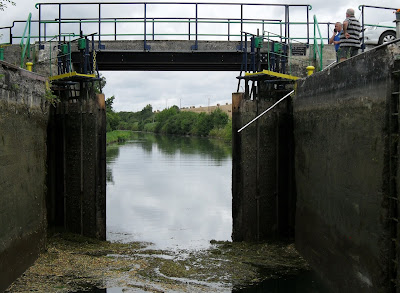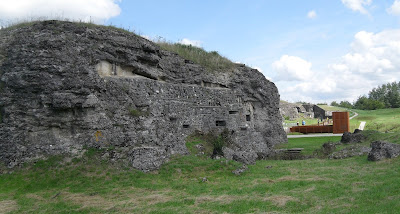It's August 12, and this is the second day in a row where it's been sunny and the temperature has exceeded 80 degrees F. I'm not sure that we quite know what to do with this suddenly summer-like weather. It was a beautiful morning for cruising as we left Verdun after a 2-day hiatus.
 |
| The water was like glass as we left Verdun |
 |
| Even the cows were in the summer spirit. One adult cow being followed by many calves looked like a summer "field" trip was taking place with the youngsters. |
 |
| Our helpful vnf employee on August 8. |
 |
| At a few of the locks today Lon was able to get off the boat and give the vnf an assist in closing the entrance gates. |
The ratio of the number of kilometers travelled to locks has remained about 4 or 5 to one, which seems just about perfect. It gives us time to look around and actually make note of our surroundings.
 |
| A "halte pique-nique" that wasn't exactly welcoming. |
 |
| Very rural countryside, beautiful horses. |
 |
| A halte fluvial that needs to remove its derelict boat. |
 |
| Military cemeteries are everywhere in this part of France. We saw this German military cemetery from the canal today. They're easy to spot because they use dark markers on the graves. |
The main focus of our attention in the past few days was the town of Verdun. The battle that took place in this area between the French and the Germans from February through December 1916 is seared into the French consciousness. The Battle of Verdun was the longest battle of the First World War, and for the French, it is the symbol of The Great War, both as an example of French determination and for the horrendous losses that were incurred. The principal French monuments of the war are located in Verdun and its environs.
The battle strategy was conceived by German general Erich von Falkenhayn. He proposed that it would be possible to break the existing stalemate in the war by tempting the French into unwise offensive attacks if the French thought that the Germans might capture Verdun. His logic was that the French were in an inferior strategic position, that if the French tried offensive attacks it would result in mass casualties for the French, and would weaken them to such a degree that they would have to withdraw from the war and would thus be unable to assist the British who were fighting further west. Suffice it to say, "Plan A" did not quite work as hoped, and there seems to have been no viable German "Plan B" as back-up. So for 10 months the French and German armies fought over the same small bit of land as the front ebbed and flowed, with not much accomplished but tremendous amounts of death and destruction. Ultimately, two French offensives in October and December of 1916 "won" the battle.
The bombardments from the fighting destroyed about 85% of Verdun, but it was never captured. The estimates of French and German military casualties seem to keep changing over the years, but approximations of 400,000 French military casualties and 350,000 German casualties, which includes about 300,000 dead between the two armies, seems to be as accurate as any. Nine villages were completely destroyed, and six were not allowed to be rebuilt. Each of the six is designated as a "Village Detruit", and their memories are maintained as villages that "died for France."
Lon and I hired a guide on August 11 to take us to some of the more "significant" sites. What a day we had!
 |
| The grounds of Fort Douaumont. The ground still shows the craters and hills created by the intensive shelling during the war. |
 |
| Standing atop the existing Fort. Craters are visible everywhere here as well. |
 |
| Glad that I don't have to use the 1917-era toilets. |
 |
| Our guide Ingrid and Pat in the damp interior of the Fort. |
 |
| The "Wounded Lion", a memorial to the defenders of Fort Souville, in particular, the 130th Division. |
 |
| Fleury was a farming community. The evidence of the bombardments is still very evident and would have made post-war agriculture impossible. |
One of the primary memorials of the Battle of Verdun in particular, and The Great War in general, is the Ossuary of Douaumont. The bombardments during the battle were so fierce and the conditions so terrible, that many soldiers' bodies were obliterated or otherwise damaged so badly that they were unrecoverable and/or unidentifiable. The building was an initiative of the Bishop of Verdun at the time, who thought that there was a need for a central location for entombment of unidentified remains and a place where families of the missing could come to mourn them. This memorial contains the skeletal remains of over 130,000 unidentified soldiers--both French and German--who died on the battlefield during the Battle of Verdun.
 |
| The Ossuary of Douaumont. The shape of the building is meant to represent the hilt of a sword with the blade buried in the ground. The cemetery in front holds about 15,000 identified French dead. |
 |
| A bit macabre, yes, but also incredibly sad to think how many families never knew for sure what happened to their loved ones. |
 |
| The War Memorial of the Citizens of Verdun who died in both World Wars. Located in the town of Verdun, the statues represent the five arms of service of the French Army engaged in the battle of 1916. |
 |
| Also in town is the Monument to Victory and to the Citizens of Verdun. It symbolizes the French victories in 1916 and 1918, and the rebuilding of the city. |
Despite extensive damage to the city from World Wars I and II, the city has managed to retain some of its older heritage, including:
 |
| Notre Dame Cathedral celebrated its millennium in 1990. It suffered several bombardments during the First World War. |
 |
| Porte Chaussee (14th C) was originally part of the city fortifications in the Middle Ages, and served as the official entry to the city. |
 |
| A portion of the wall of the 18th century Saint Nicolas' Chapel, still bearing the marks from shells and shrapnel from two world wars. |
 |
| The 12th century Chatel Gate is the oldest gateway in Verdun. It used to be joined to protective ramparts. |
As we continue north we will never be far from reminders of the terrible wars of the last century. Tonight we are on a dock in the quiet village of Vilosnes-Haraumont. It, too, suffered bombardment damage in WWI, and is basically a residential community today, but the setting is lovely, sitting as it does in the river valley surrounded by hills.
 |
| X marks our spot today. We continue to descend, although at a more relaxed pace than our previous changes in elevation. |





How moving to see all the monuments to the brave souls who fought for country. Amazing and impressive the work to create those monuments.
ReplyDelete